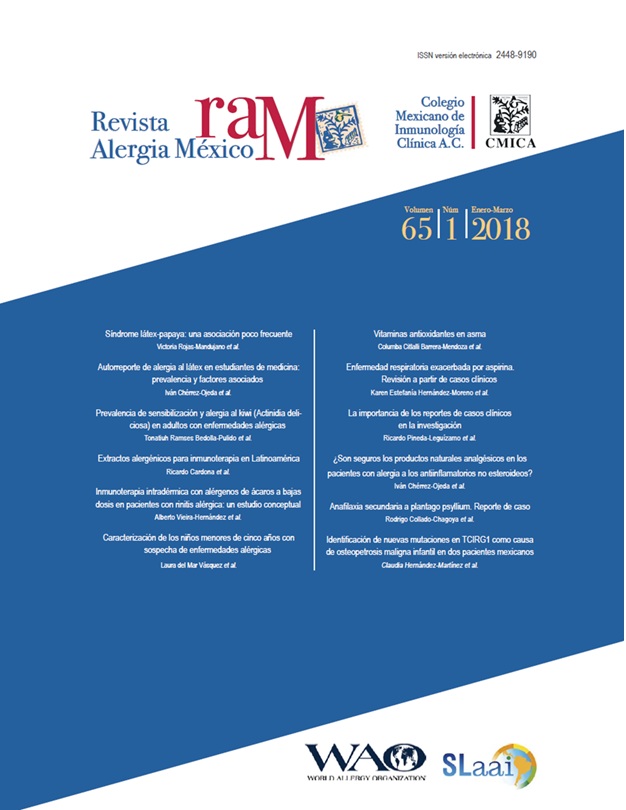Abstract
Background: Nonsteroidal anti-inflammatory drugs (NSAID)-induced hypersensitivity reactions can be clinically apparent with asthma, rhinosinusitis, anaphylaxis or rash. Although natural anti-inflammatory products can have similar components, they are not subjected to rigorous quality control standards.
Case report: The case is presented of a 22-year-old female with NSAID allergy who attended with facial and laryngeal angioedema associated with pruritus in eyelids and pharynx. She developed these symptoms fifteen minutes after taking an over-the-counter (OTC) natural anti-inflammatory product. She received treatment with epinephrine, antihistamines and corticosteroids.
Conclusion: Different natural anti-inflammatory products are freely available both OTC and online. Some contain dangerous substances that can cause important, and even lethal. side effects. Allergologists, dermatologists and general practitioners should be able to recognize that the consumption of these products, which is widely spread, can cause angioedema.References
Fischer FH, Lewith G, Witt CM, Linde K, Von-Ammon K, Cardini F, et al. High prevalence but limited evidence in complementary and alternative medicine: guidelines for future research. BMC Complement Altern Med. 2014;14:46. DOI: 10.1186/1472-6882-14-46
Faulkenberg T. Traditional and complementary medicine policy. En: Embrey M, Ryan M (eds.). MDS-3: Managing access to medicines and health technologies. EEUU: Management Sciences for Health; 2012.
Astin JA. Why patients use alternative medicine: results of a national study. JAMA. 1998;279(19):1548-1553. DOI: 10.1001/jama.279.19.1548
Morris CA, Avorn J. Internet marketing of herbal products. JAMA. 2003;290(11):1505-1509. DOI: 10.1001/jama.290.11.1505
Shara M, Stohs SJ. Efficacy and safety of white willow bark (salix alba) extracts. Phytother Res. 2015;29(8):1112-1116. DOI: 10.1002/ptr.5377
Kowalski ML, Makowska JS, Blanca M, Bavbek S, Bochenek G, Bousquet J, et al. Hypersensitivity to nonsteroidal anti-inflammatory drugs (NSAIDs)-classification, diagnosis and management: review of the EAACI/ENDA(#) and GA2LEN/HANNA*. Allergy. 2011;66(7):818-829. DOI: 10.1111/j.1398-9995.2011.02557.x
Jares EJ, Sánchez-Borges M, Cardona-Villa R, Ensina LF, Arias-Cruz A, Gómez M, et al. Multinational experience with hypersensitivity drug reactions in Latin America. Ann Allergy Asthma Immunol. 2014;113(3):282-289. DOI: 10.1016/j.anai.2014.06.019
Garcia-Cruz ML, Jimenez-Chobillon MA, Teran LM. Rhinosinusitis and aspirin-exacerbated respiratory disease. J Allergy (Cairo). 2012;2012:273752.
Calderón JC, Dávila F, Mantilla R, Chérrez A, Calero E, Cabrera D, et al. Conocimiento y actitudes en médicos ecuatorianos sobre enfermedades respiratorias exacerbadas por aspirina. Rev Alerg Mex. 2017;64(1):13-23. DOI: 10.29262/ram.v64i1.219
Boullata JI, McDonnell PJ, Oliva CD. Anaphylactic reaction to a dietary supplement containing willow bark. Ann Pharmacother. 2003;37(6):832-835. DOI: 10.1345/aph.1D027
Eisenberg DM, Davis RB, Ettner SL, Appel S, Wilkey S, Van-Rompay M, et al. Trends in alternative medicine use in the United States, 1990-1997: results of a follow-up national survey. JAMA. 1998;280(18):1569-1575. DOI: 10.1001/jama.280.18.1569
Klak A, Raciborski F, Krzych-Falta E, Opoczynska-Swiezewska D, Szymanski J, Lipiec A, et al. Persons with allergy symptoms use alternative medicine more often. Pneumonol Alergol Pol. 2016;84(5):251-257. DOI: 10.5603/PiAP.2016.0031
Sommer DD, Rotenberg BW, Sowerby LJ, Lee JM, Janjua A, Witterick IJ, et al. A novel treatment adjunct for aspirin exacerbated respiratory disease: the low‐salicylate diet: a multicenter randomized control crossover trial. Int Forum Allergy Rhinol. 2016;6(4):385-391. DOI: 10.1002/alr.21678
Simons KJ, Simons FE. Epinephrine and its use in anaphylaxis: current issues. Curr Opin Allergy Clin Immunol. 2010;10(4):354-361. DOI: 10.1097/ACI.0b013e32833bc670

This work is licensed under a Creative Commons Attribution-NonCommercial 4.0 International License.
Copyright (c) 2018 Revista Alergia México

